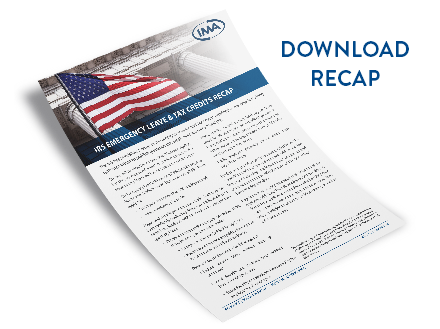COVID-19
IRS Emergency Leave and Tax Credits Recap
The IRS has additionally provided in the new law their intent to publish guidance this week.
Coronavirus has had an impact on the ability of businesses to perform obligations under many different circumstances. It is prudent for businesses to review new laws and determine how they will be impacted by this pandemic.
IRS Emergency Leave and Tax Credits Recap
The IRS has published a recap of the emergency leave and tax credits provided in the new law along with their intent to publish guidance this week.
Here are some highlights:
The law will be effective no later than Thursday, April 2, but they’ve expressed intent to publish guidance this week so employers will have access to tax credits ASAP
The Emergency Paid Sick Leave Act (EPSL) and Emergency Family and Medical Leave Expansion Act (EFML) both apply to:
- Employers with fewer than 500 employees, and
- Public employers of any size
Wages and benefit premiums paid under both laws can be immediately credited against a non-public employer’s payroll tax liabilities without needing to wait for their quarterly filings
- Private and non-profit employers can deduct 100% of the following as refundable credits:
- Emergency leave pay (subject to caps), and
- Health insurance premiums paid by the employer for employees taking these new leaves.
- These can be credited dollar for dollar against:
- Federal income taxes withheld from all employees,
- Social Security and Medicare taxes withheld from all employees, and
- Social Security and Medicare taxes owed by the employer for all employees.
- Where credits claimed exceed total payroll taxes owed for all employees, an expedited process is being created for employers to request a refund as if they overpaid their payroll taxes, to be paid to the employer within two weeks
- Public employers generally cannot claim these payroll tax credits
The first 30 days of the new leaves being effective will be a transition period of nonenforcement, with regulators focusing on assisting employers to get caught up and compliant retro to the effective date of the law, rather than enforcing penalties
Regulators have already expressed their intent to allow employers with fewer than 50 employees to have simple, clear criteria to follow in determining whether they may claim a hardship exemption from the new leave laws solely in relation to caring for children during school or child care closures
This material is for general information only and should not be considered as a substitute for legal, medical, tax and/or actuarial advice. Contact the appropriate professional counsel for such matters. These materials are not exhaustive and are subject to possible changes in applicable laws, rules, and regulations and their interpretations.
